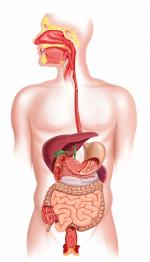|
This section contains 1,024 words (approx. 4 pages at 300 words per page) |

|
Digestion is the process of breaking down food into molecules that cells can absorb. Carbohydrates, proteins, nucleic acids, and fats are broken down into their smallest units (monomers) by digestive enzymes. These hydrolytic enzymes break chemical bonds through a reaction that requires water. Each hydrolytic enzyme is named after the substances it hydrolyzes. For example, carbohydrases break carbohydrates into single sugars (monosaccharides), proteases break proteins into amino acids, nucleases break nucleic acids into nucleotides, and lipases hydrolyze fats to fatty acids.
The Digestive System
The digestive system of humans consists of a one-way digestive tract with several specialized chambers along the way—mouth, stomach, small intestine, and large intestine. Each chamber has a specific function. In the human digestive system, digestion starts in the mouth. There food is physically digested by the action of our jaws and teeth, which break it down into smaller pieces, increasing the surface...
|
This section contains 1,024 words (approx. 4 pages at 300 words per page) |

|


